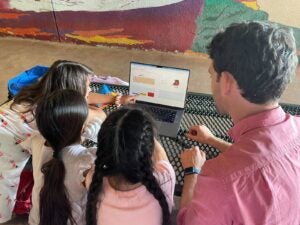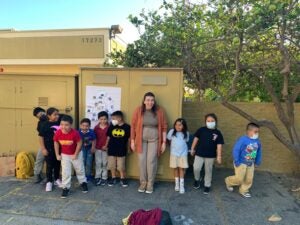WonderKids Returns to In Person After-School Programs!

Fall 2022 was the first semester post-Covid that WonderKids rebooted its in-person programming. Two ReadersPLUS sites were chosen to host the after-school program this fall: 32nd Street Magnet School, with a group of around 15 students participating; and Norwood Street Elementary with a group of 25 students. With the guidance of their ReadersPLUS teams, the WonderKids students were able to explore 3 different STEM units full of hands-on activities this semester.
Stem Cells:
Stem Cells are a field on the frontier of biological research, one that is often misrepresented and therefore controversial. All of us, no matter our age, have many different kinds of “adult stem cells” in our bodies. These adult stem cells are responsible for replenishing our bodies’ organ systems with the cells they need to function. For example, blood stem cells receive chemical signals from the rest of our blood and can become a red blood cell, a white blood cell or a platelet depending on what our bodies need! Our WonderKids students learned about this process throughout our stem cells unit. The first lesson included a Play-doh model of how different kinds of cells make up different tissues and organs which make up our bodies’ organ systems such as our skin, or our circulatory system. In our second lesson, students learned more about the kinds of cells that make up our blood by making a model of human blood using a water bottle and grocery store ingredients, such as corn syrup and kidney beans! Our Norwood Street School site was visited by Dr. Adam MacLean, a stem cell researcher at USC, for lesson 3. He introduced the children toa game meant to mimic how stem cells in our blood know what kind of cell they need to become based on chemical signals. Dr. MacLean was also able to share our final lesson with the WonderKids students at Norwood, while his postdoctoral student, Jesse Kreger, did the same for our 32nd St. School site. This final lesson iwas based on the research that Dr. MacLean’s lab works on; it is a web-based computer simulation game about figuring out how to balance the amounts of different kinds of blood cells (red, white, stem) to make a healthy and happy organism–in this case, a strawberry who is also a superhero!

Soft Robotics:
Soft robotics is a new field emerging out of the robotics industry. Soft robots are made out of materials that are soft, vulnerable and flexible. This is the complete opposite of what we normally think about robots, being made out of hard plastic and impervious to damage. The field of soft robotics centers around the design and construction of robots with physically flexible-bodies and electronics. These concepts were integrated into three lessons that were taught to elementary students. The first lesson focused on how soft robotics materials are created and designed. We had various swatches of robotics materials, ranging from hardest to softest as seen below. Afterwards, students used Eco-FLEX 035 and a robot ice tray to create their own mini robot made out of soft materials (although not functional, it drove home the idea of robots being made out of soft materials instead of hard plastic). The second lesson focused on soft grippers. Students learned that the field of soft robotics also includes robotic arms or grippers that are more flexible than the hard plastic robotic arms. For the third lesson, students learned how to program a humanoid soft robot that will lead it back into homeostasis. Our WonderKids had a blast learning more about how robots interpret commands using Ozobots!
Astrobiology:
The study of and search for life beyond Earth (or aliens!) is a tough field to nail down. To express the diversity of research done in this field and the inherent interdisciplinary nature of astrobiology, our lessons covered various topics. Students began by learning about our planets and Solar System. How did planets form and specifically how did Saturn get its rings? Students created edible Saturn models following the steps of Solar System formation. Then students discovered how we explore space and what we have learned about Saturn and its moons from the Cassini-Huygens mission, by building a model of the Cassini spacecraft. At this point, students had primarily focused on space, but that is only one half of astrobiology. Students then learned how we approximate environmental conditions of other worlds and how microbes might compete. How do we decide what type of life to look for? Students pretended to be different microbes, with different advantages or disadvantages in each environment. They made predictions about whether one type of microbe was more likely to survive than the other. To tie it all together, our guest speaker, USC Ph.D. Student Maya Yanez (who developed and tested these lessons for WonderKids this semester), taught the final astrobiology activity entitled Bacteria Soup! Students learned that in order to test which microbes could survive, scientists must grow them in the lab under different conditions. They helped Maya build a bottle full of all the vitamins, nutrients, and minerals that are needed to grow bacteria.